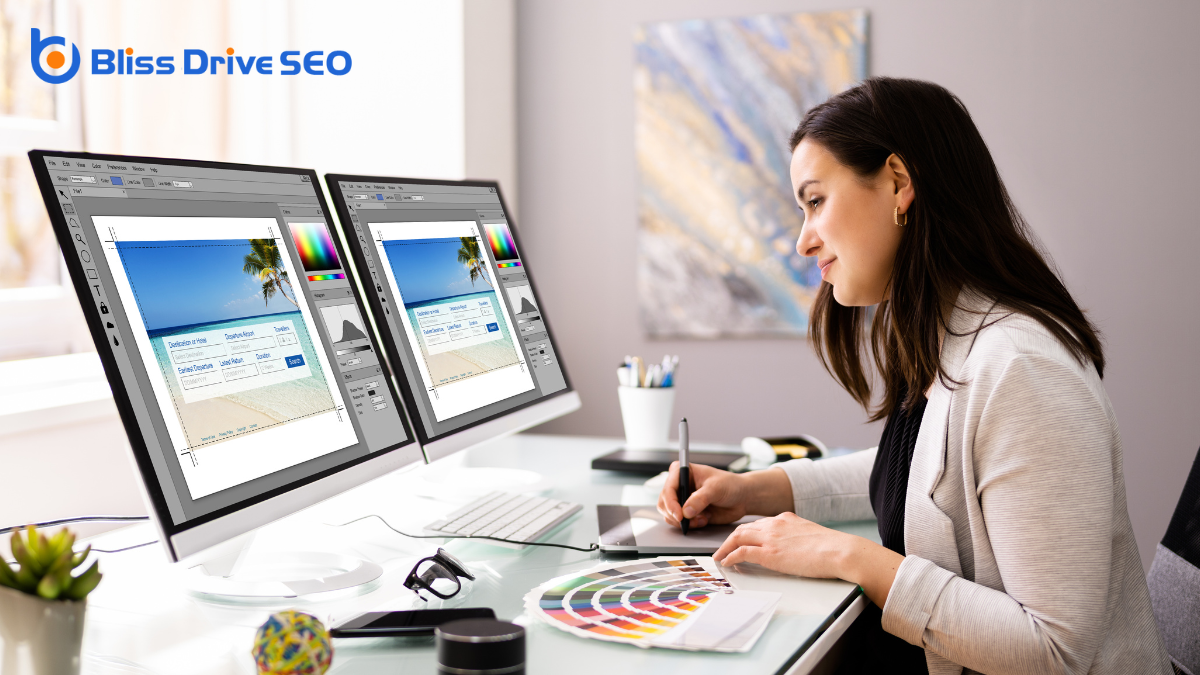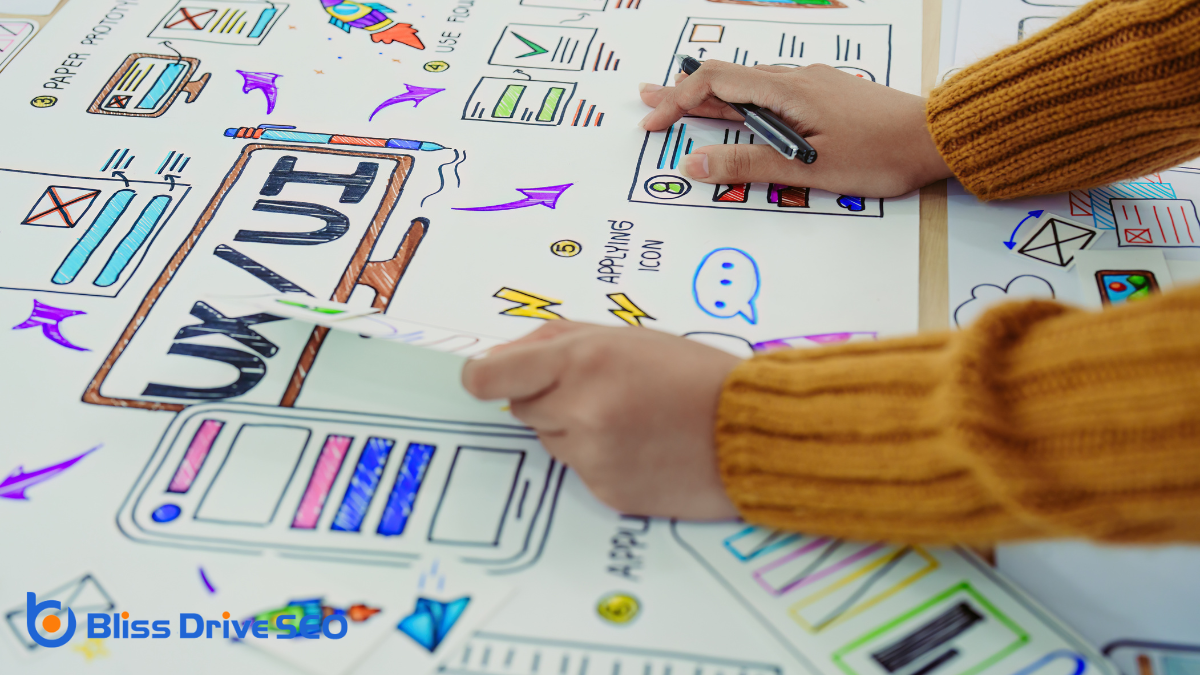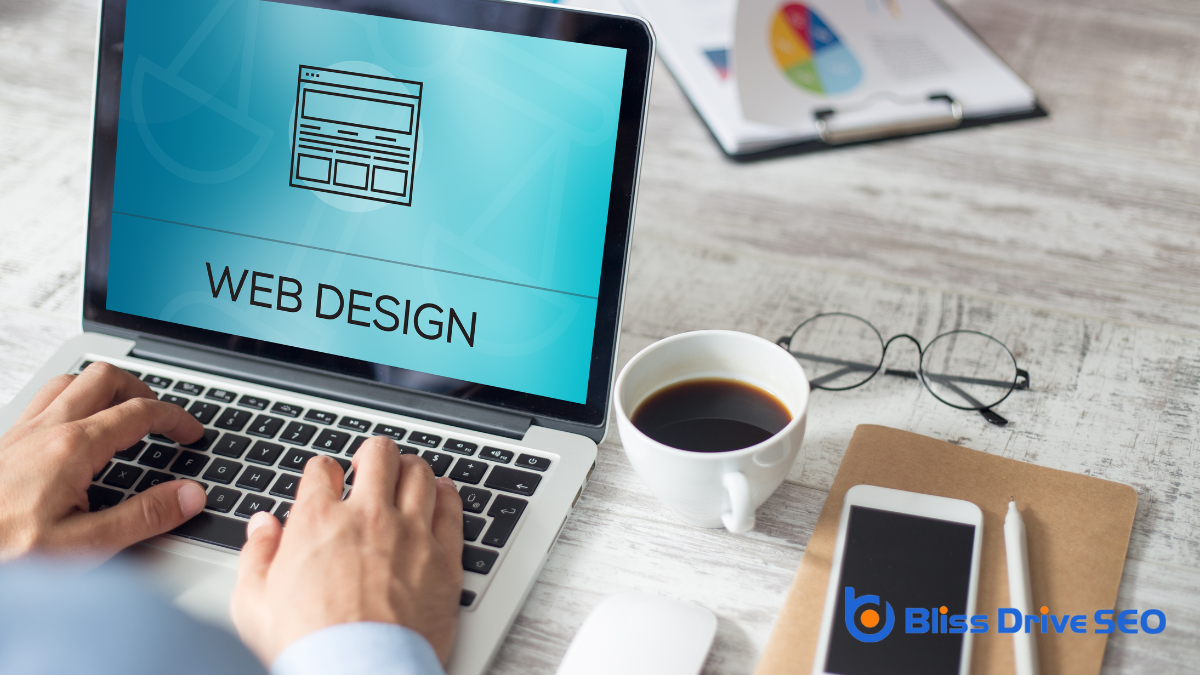Digital Marketing Services
Learn More About Us

When you think about web designing, imagine crafting a digital space that's both inviting and functional, much like setting up a cozy coffee shop that pulls people in. It's about blending artistry with utility, using tools like HTML and CSS to build layouts that speak to your audience. Picture an e-commerce site where every image, review, and button is strategically placed to guide a shopper effortlessly. But what really makes a design effective, and how do you keep users coming back for more? There's more to uncover as we explore the intricacies of web design and its impact.
Understanding web design is vital for creating effective and engaging websites. When you immerse yourself in web design, you're not just picking colors or placing images; you're crafting experiences. Your goal is to make certain visitors can navigate smoothly, find information easily, and enjoy their time on your website. It's about blending functionality with aesthetics to guarantee users are both informed and delighted.
Web designing involves a variety of skills and disciplines. You need to be familiar with HTML, CSS, and possibly JavaScript, as these are the building blocks of any website. But it doesn't stop there. You'll also need to understand the principles of user experience (UX)The overall experience a user has when interacting with a website or application, including usabilit... and user interface (UI) design. These principles help you organize content logically and create a layout that's intuitive to users.
In the world of web design, keeping up with trends is imperative. Styles and technologies evolve rapidly, so staying current guarantees your designs are fresh and relevant.

When you're focusing on web design, two critical elements to master are visual design principles and user experience.
Visual design isn't just about aesthetics; it shapes how users interpret and interact with your site.
Prioritizing user experience guarantees your website is intuitive and engaging, keeping visitors coming back.
Though web design encompasses various aspects, the visual design principles form its core, guiding the creation of aesthetically pleasing and functional websites. When you grasp these principles, your web designs won't just look good; they'll communicate effectively with your audience.
Start by considering balance, which guarantees a stable appearance across your site. Distribute elements evenly, whether you're aiming for symmetrical or asymmetrical balance, to maintain harmony.
Contrast plays an essential role in making important elements stand out. Use it to emphasize key points by varying color, size, or font. It helps direct attention where you want it most.
Next, consider alignment, which keeps your content organized and readable. Proper alignment avoids a messy look and makes navigation intuitive.
Another principle, repetition, reinforces your brand's identity through consistent use of colors, fonts, and styles. This consistency builds familiarity and trust with your users.
Finally, focus on white space, or the empty space around elements. Don't underestimate its power. It provides breathing room and guides the viewer's eye naturally through the content.
A website's success hinges on its user experience (UX) design, which guarantees that visitors find it intuitive and engaging. When designing a site, focus on how users will interact with it. You want them to navigate effortlessly, find information quickly, and enjoy the overall experience. This means considering layout, accessibility, and responsiveness to ascertain everything works smoothly across all devices.
Think about your target audience and their needs. What do they expect to accomplish on your site? If it's an e-commerce site, they should easily browse and purchase products. If it's informational, they should locate content with minimal effort. Use clear calls to action and logical navigation paths to guide users seamlessly through their journey.
Also, pay attention to loading times. No one likes waiting for pages to load—slow sites can frustrate users and drive them away. Optimize images and streamline code to keep your site fast and efficient.
Incorporate user feedback to refine and improve the experience continually. Testing and iterating based on real user interactions help you create a website that not only looks good but also functions excellently, assuring a satisfying user experience every time.
In the dynamic field of web design, a web designer plays an indispensable role in crafting visually appealing and user-friendly websites. As a web designer, you're the creative force behind the layout, color scheme, typography, and overall aesthetics of a site. You guarantee that the website isn't just visually stunning but also aligns with the brand's identity and message.
By focusing on the user's experience, you design intuitive navigation and guarantee information is accessible and engaging. Your job involves understanding the client's needs and translating them into a digital format that resonates with the target audience. This means you'll need to balance creativity with functionality, making sure that every design element serves a purpose.
Communication is essential, as you'll collaborate with clients, developers, and other team members to bring your vision to life. You'll also stay updated on the latest design trends and technologies. This helps you create modern websites that meet current user expectations.
Problem-solving skills are important because you'll often need to find innovative solutions to design challenges. Ultimately, your role is to create websites that captivate users and provide a seamless, enjoyable experience.
When you're diving into the world of web design, having the right tools at your disposal can make all the difference.
These tools help streamline your workflow, enhance creativity, and guarantee the final product is both functional and visually appealing.
By equipping yourself with the right resources, you can tackle web design projects with confidence and efficiency.
Here's a list of essential web design tools you should consider:

Having the right tools sets the stage for an effective design process, but understanding the core principles of effective design truly elevates your work. These principles guide you to create visually pleasing and functional websites.
First, embrace simplicity. A clutter-free design makes your site easy to navigate and enhances user engagementThe level of interaction and involvement users have with social media content..
Next, focus on balance. Distribute elements evenly across your page to create a sense of harmony, whether through symmetrical or asymmetrical layouts.
Contrast is also essential. It highlights important sections and guarantees readability, often achieved through variations in color, size, or typography.
Speaking of typography, choose fonts wisely. They should be legible and suit the website's tone.
Alignment is another key principle. Proper alignment creates a clean structure, helping users easily find information.
Consistency can't be overlooked. Use uniform colors, fonts, and styles across all pages to build trust and guarantee a seamless experience.
Finally, think about the hierarchy. Organize content logically, using headings and subheadings to guide users through information effortlessly.
Every great website prioritizes user experience and interface, driving engagementThe interactions that users have with a brand’s content on social media. and satisfaction. When you design a website, focusing on how users interact with it is essential. A seamless user experience (UX) means your visitors find what they're looking for easily and enjoyably. The user interface (UI) complements this by providing an aesthetically pleasing and intuitive design.
Consider these key aspects to enhance UX and UI:
In today's digital world, you can't overlook the importance of responsive designA web design approach that makes web pages render well on a variety of devices and window or screen ... in enhancing user experience.
By adapting to different screen sizes, your website guarantees that visitors enjoy a seamless and engaging interaction, whether they're on a phone or a desktop.
This approach also improves site accessibility, making your content available to a wider audience, including those with varying needs and devices.
Responsive design is essential for enhancing user experience in today's digital age. It guarantees that your website looks great and functions well on every device, from smartphones to desktops.
By focusing on responsive design, you can meet your users' expectations and provide a seamless experience, which is vital for retaining visitors and encouraging them to explore your site further.
When you prioritize enhancing user experience through responsive design, consider the following benefits:
Imagine visiting a website where the text spills off the screen or buttons overlap, making it frustrating to navigate. This is what happens when a site isn't designed to adapt to different screen sizes.
In today's world, people use various devices like phones, tablets, and desktops to access websites. If your site doesn't modify to these screen sizes, you risk losing visitors who can't easily interact with your content.
Responsive design guarantees your website looks and functions well on any device. It's all about creating a flexible layout that adapts to the user's screen. You want images to resize appropriately, text to remain readable, and navigation to stay intuitive.
By implementing responsive design, you enhance the user experience, making it seamless regardless of the device.
To achieve this, use flexible grids, responsive images, and CSS media queries. These tools help your site dynamically adjust its elements.
As you guarantee your website adapts to various screen sizes, you also need to focus on improving site accessibility. Accessibility guarantees everyone, including individuals with disabilities, can use your site without barriers.
By prioritizing this, you enhance user experience and broaden your audience reach. Here's how to make your site more accessible:

Amidst the complex world of web design, examining a real-world case study can illuminate practical strategies and common pitfalls.
Consider the transformation of Airbnb's website. Initially, the site faced issues with user navigation and slow loading times. These problems often deterred potential users and affected overall engagement. By analyzing user feedback and conducting thorough usability testingEvaluating a website's ease of use by testing it with real users and gathering their feedback., Airbnb's design team identified key areas requiring improvement.
They focused on simplifying the user interface, making navigation intuitive and seamless. By optimizing images and streamlining the code, they markedly reduced loading times, enhancing user experience.
Additionally, Airbnb adopted a mobile-first approach, ensuring that the site functioned efficiently across all devices. This strategic shift not only improved accessibility but also increased their user base.
Throughout this redesign process, Airbnb maintained a consistent visual identityThe visual elements of a brand, including logo, typography, colors, and design elements., reinforcing brand recognitionThe ability of consumers to identify a brand by its attributes, such as logo, color, or packaging.. They used A/B testingA method of comparing two versions of a web page or app against each other to determine which one pe... to evaluate changes, ensuring every decision was data-driven and user-centric.
By prioritizing user experience and leveraging technology effectively, Airbnb transformed its website into a powerful tool for connection.
In this case study, you can see how focusing on simplicity, speed, and consistency can turn web design challenges into opportunities for growth and success.
The landscape of web design is rapidly evolving, driven by technological advancements and changing user expectations. As a budding web designer, you need to stay ahead of the curve by embracing emerging trends that are shaping the future of web design.
Here are some key trends you should watch:
These trends aren't just buzzwords; they're shaping how users interact with the digital world.
By incorporating these elements into your designs, you can improve user engagement and remain competitive.
Remember, keeping your skills updated with these innovations isn't just an option—it's a necessity in today's fast-paced digital landscape.
Stay curious, keep learning, and your web designs will continue to shine.
In web designing, you're crafting more than just a website; you're creating an experience that combines aesthetics and functionality. As a web designer, you guarantee each element—from color schemes to user interfaces—works harmoniously to engage users. By keeping up with modern trends and prioritizing responsive design, you guarantee accessibility and satisfaction across devices. Remember, a well-designed site isn't just visually appealing; it's a powerful tool that communicates effectively and meets users' needs seamlessly.
